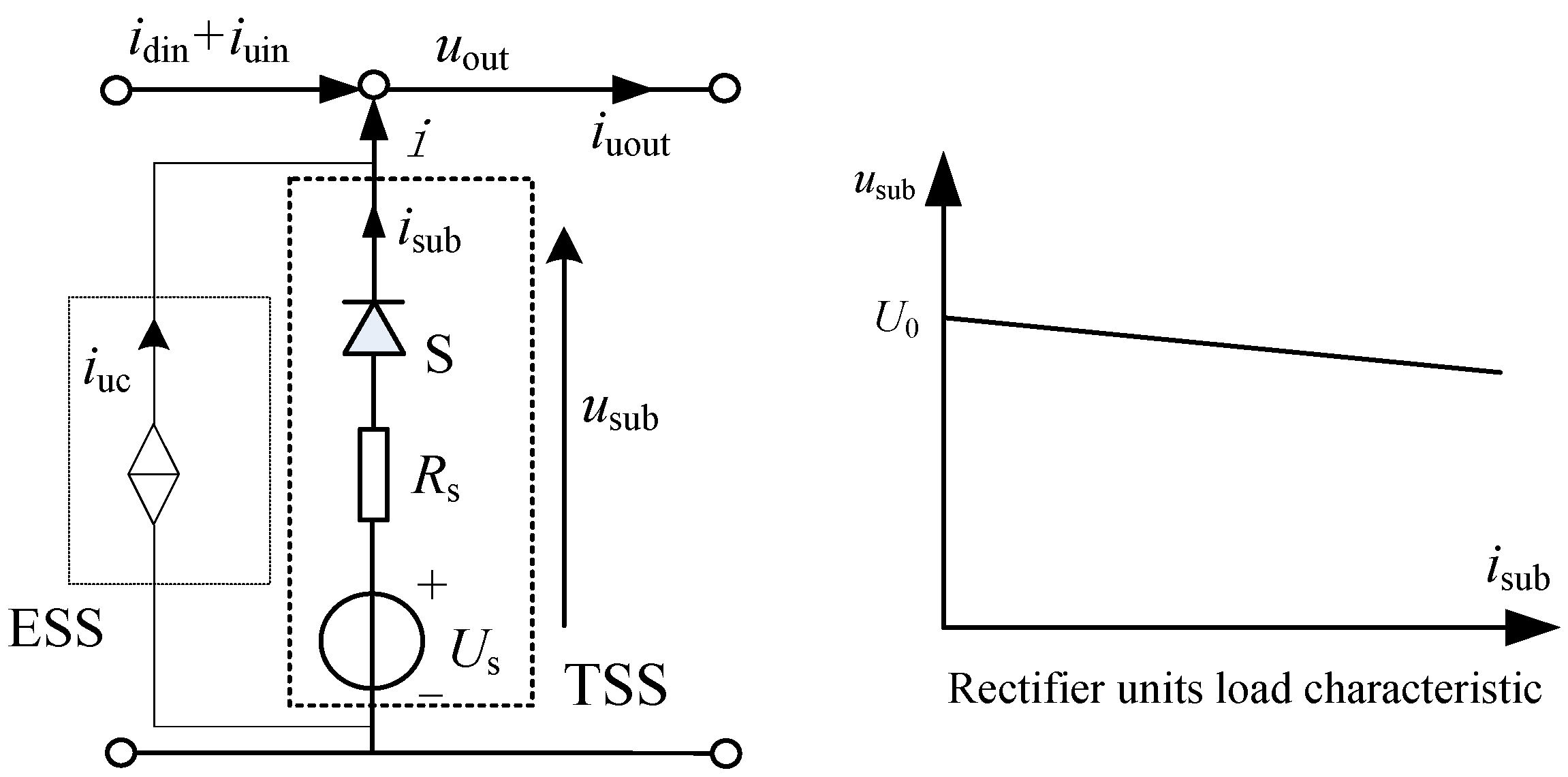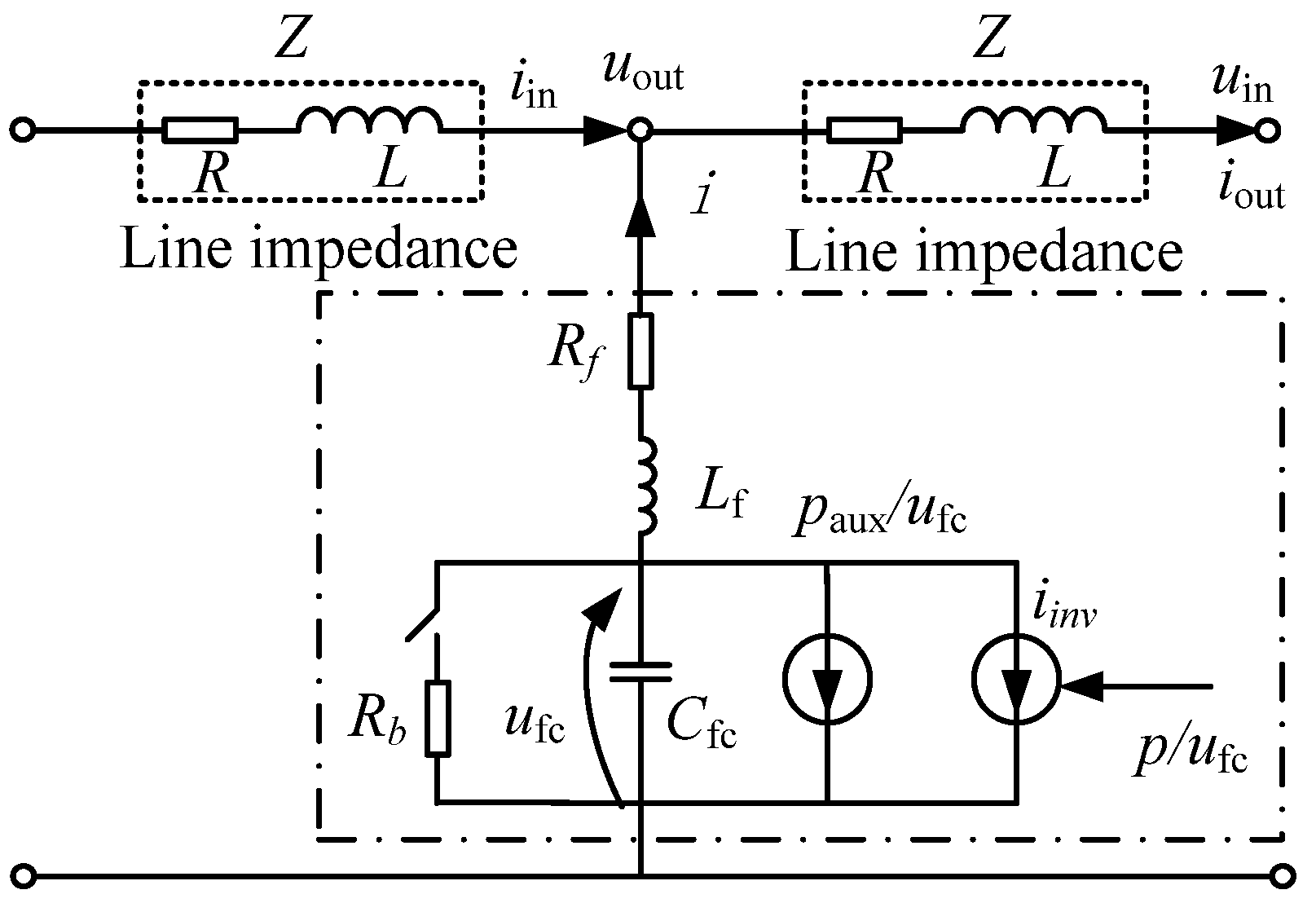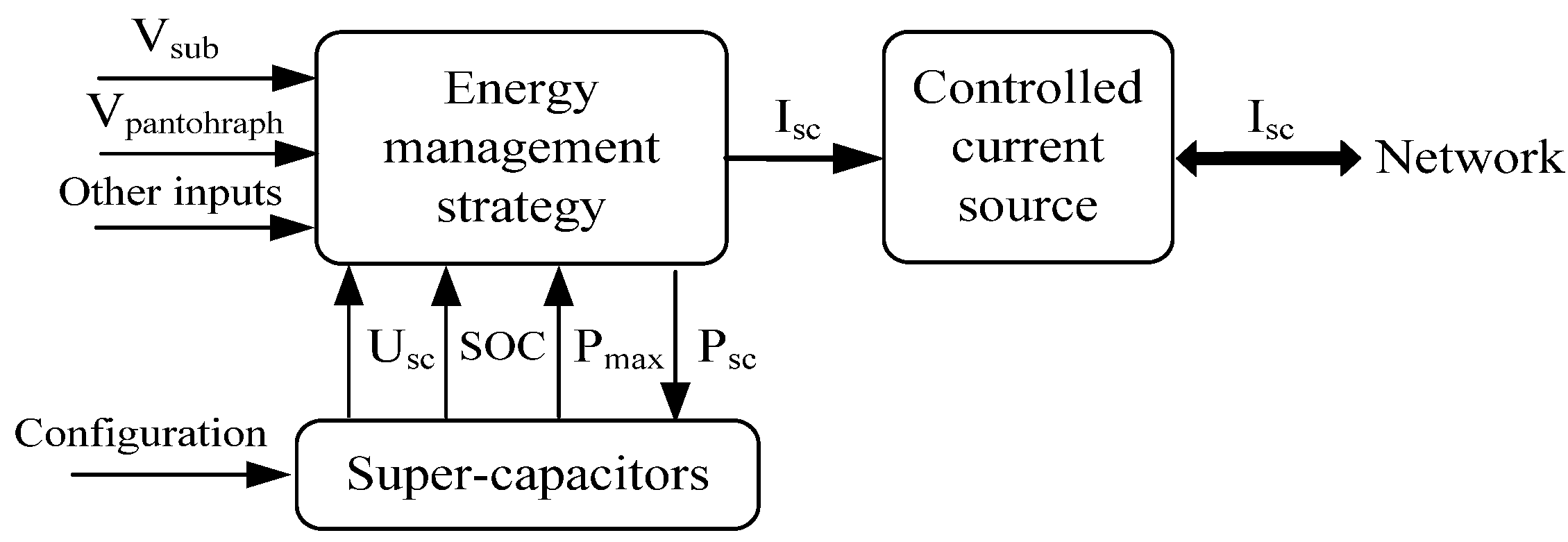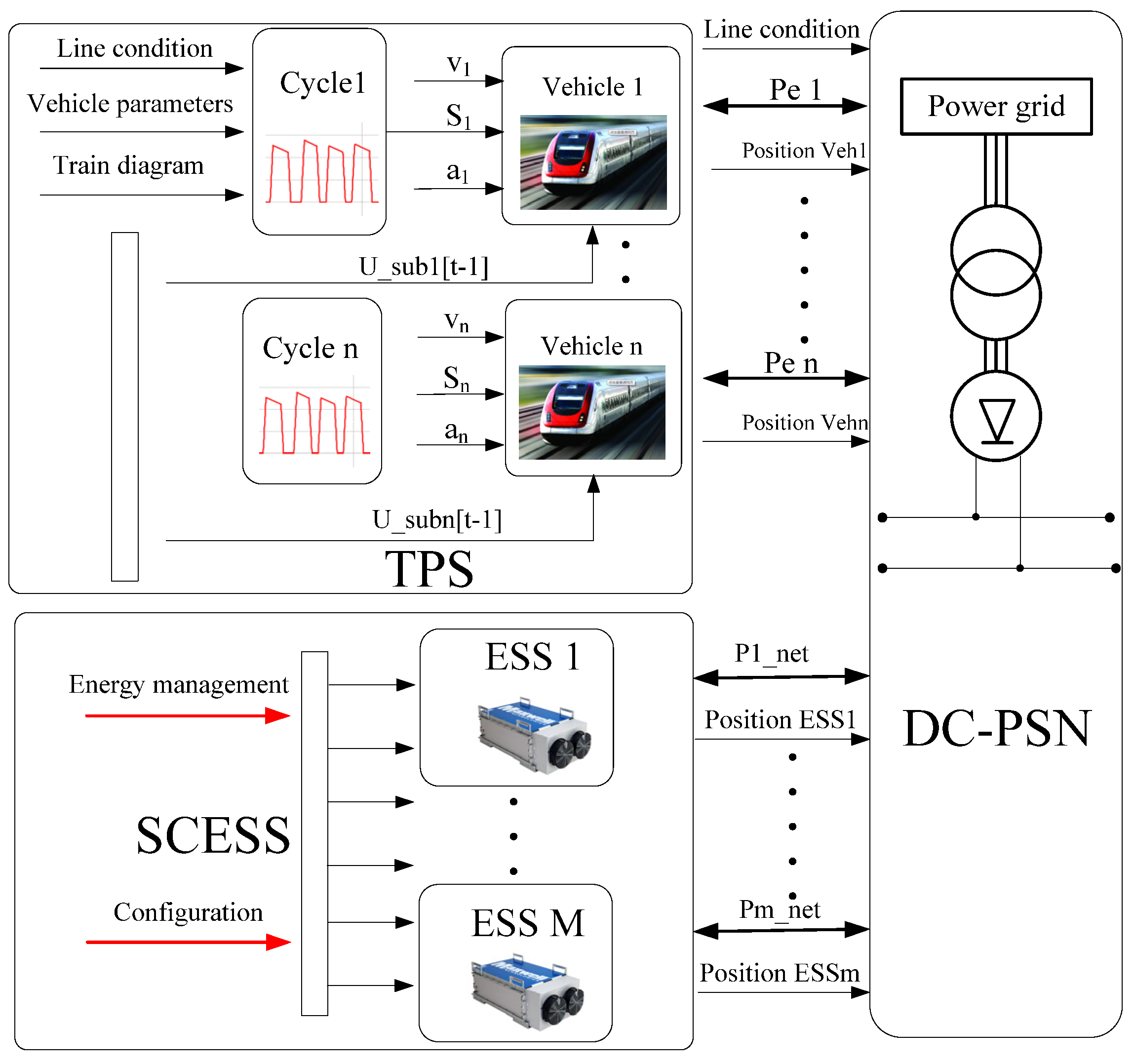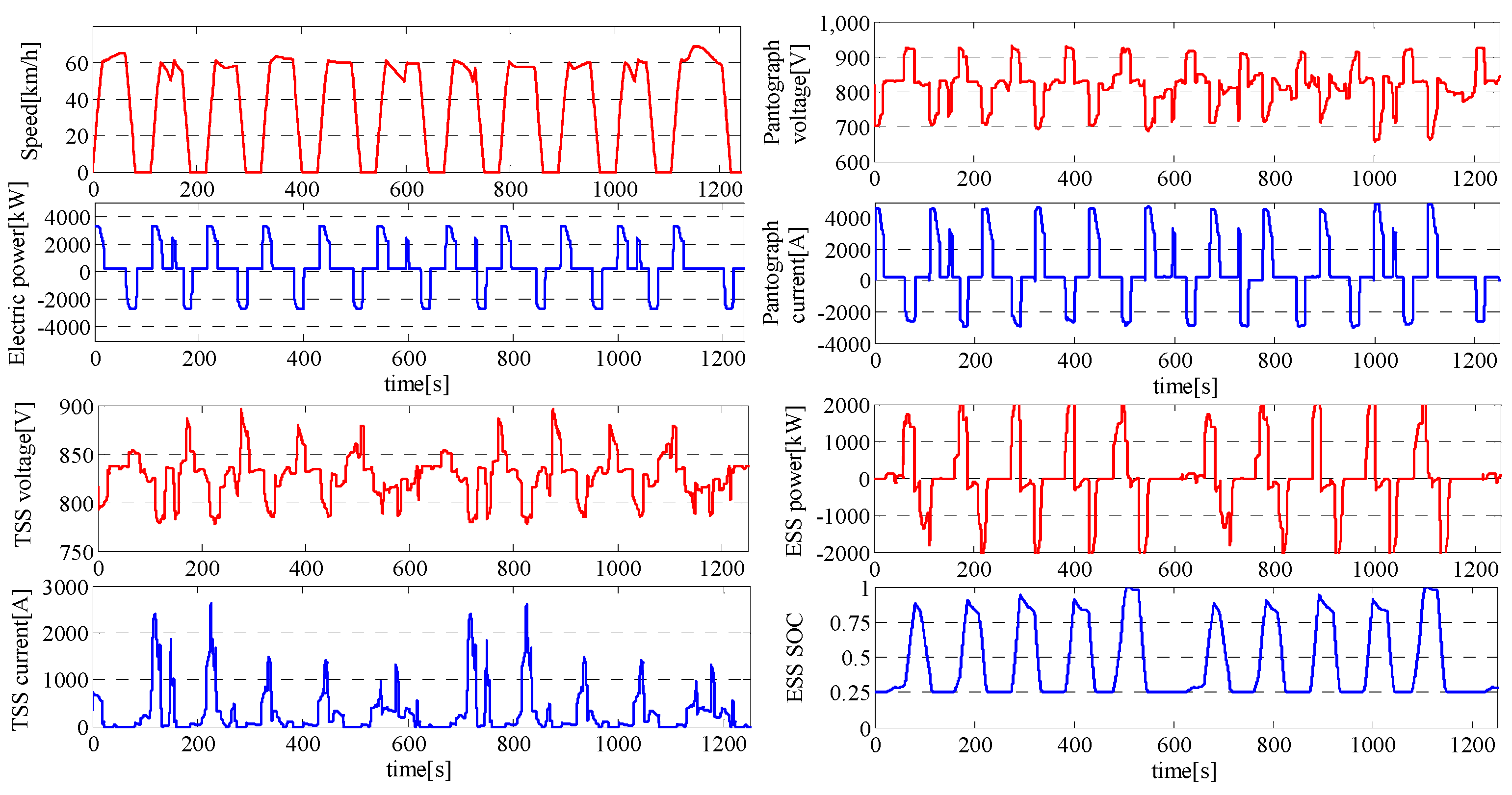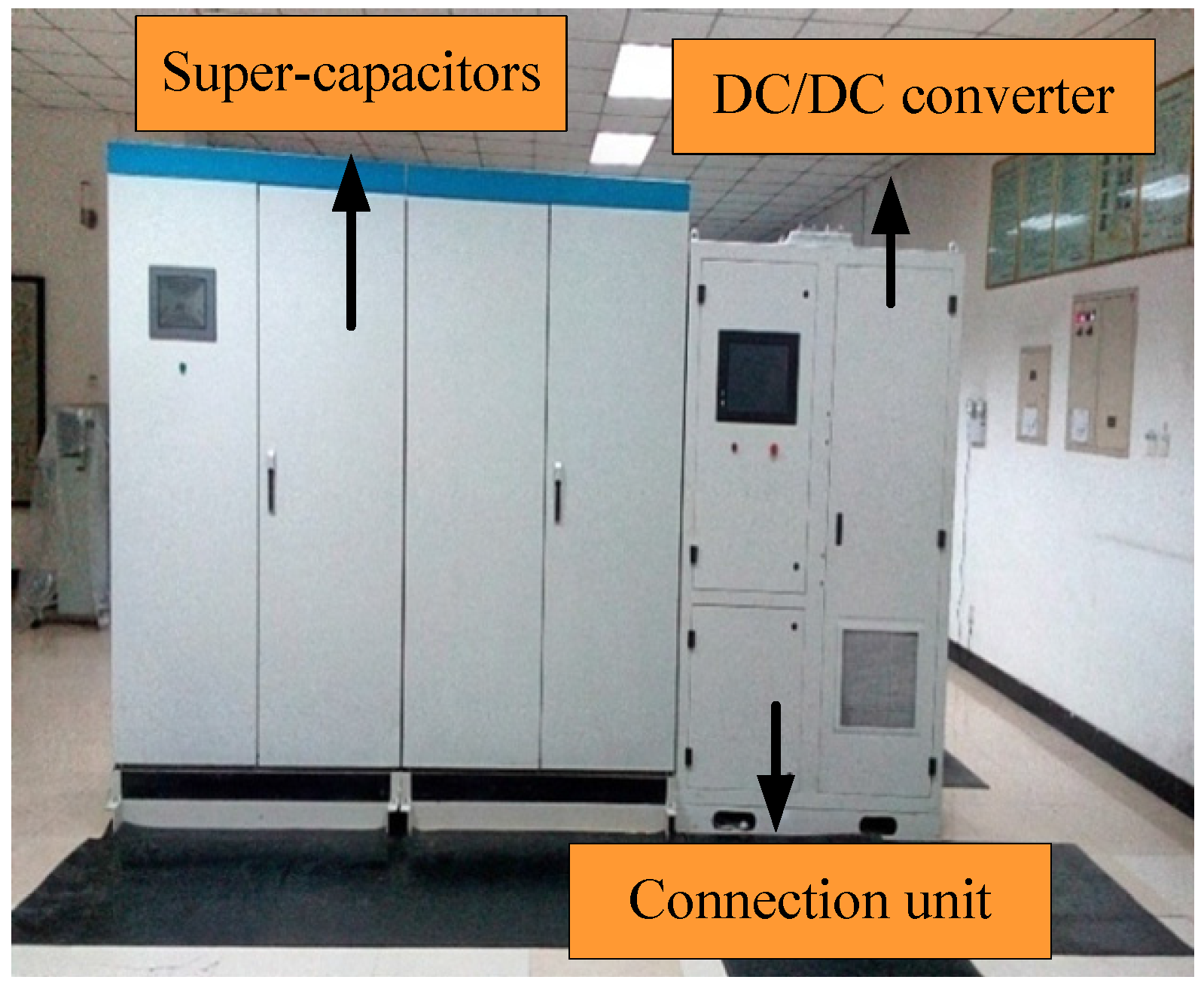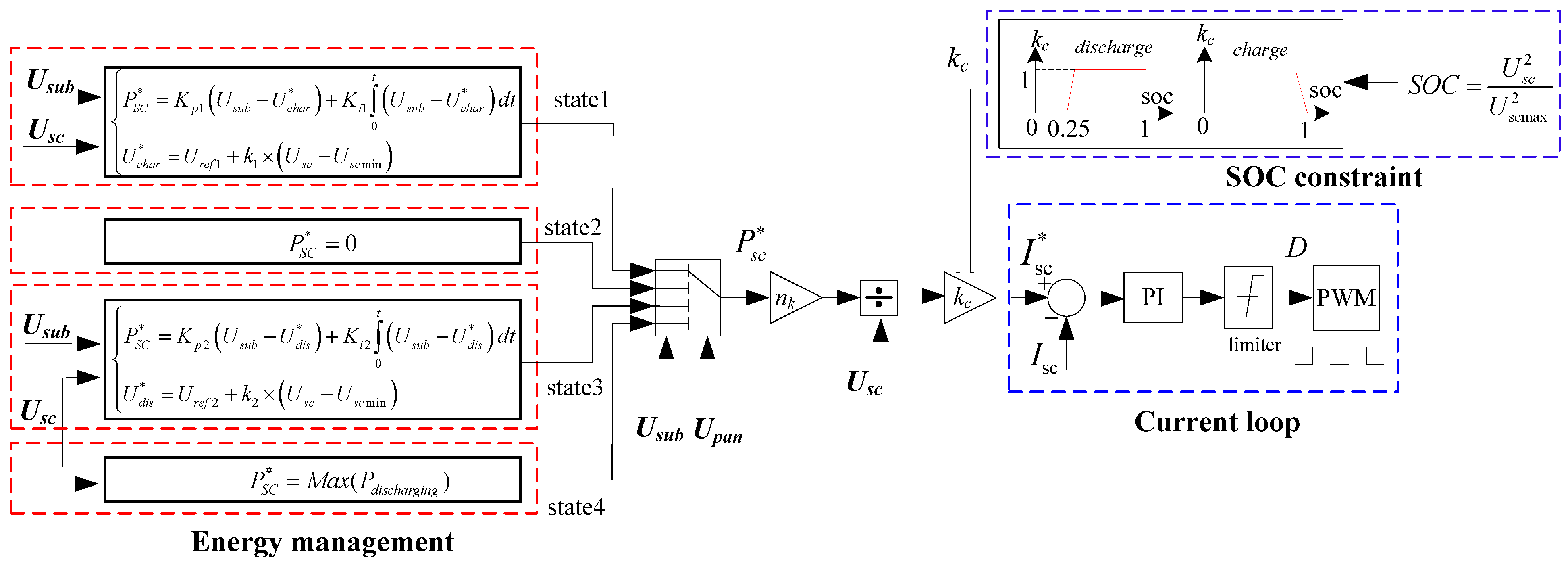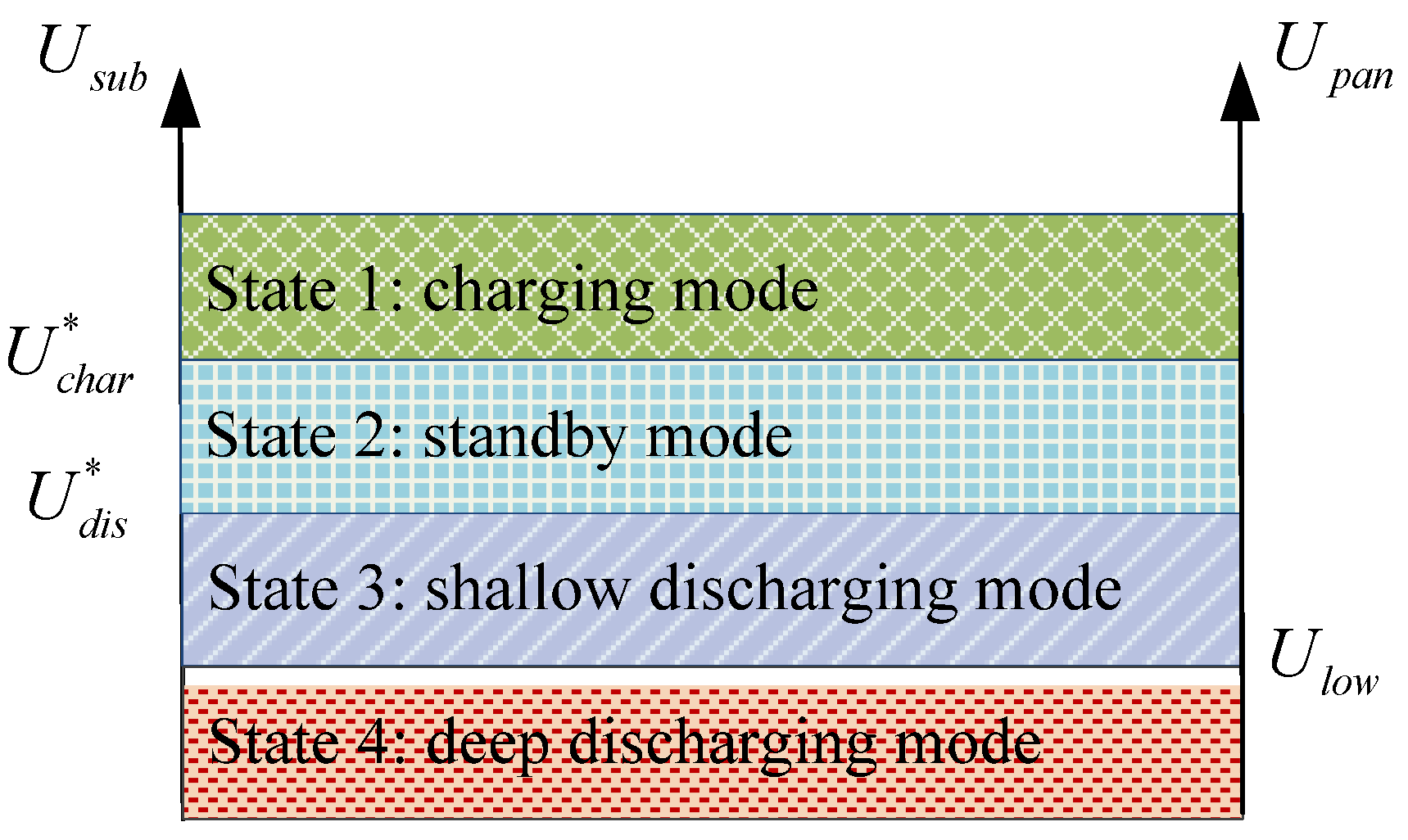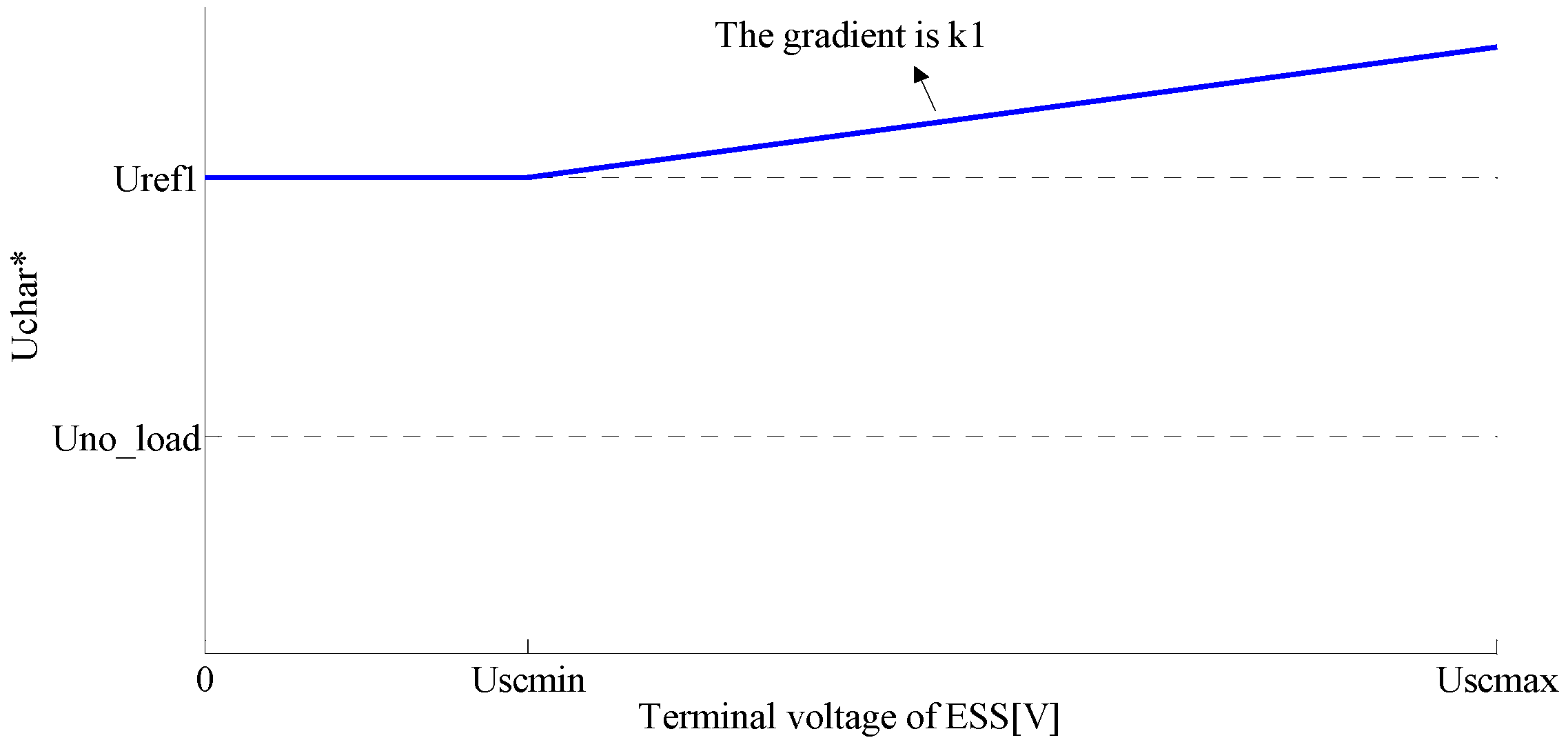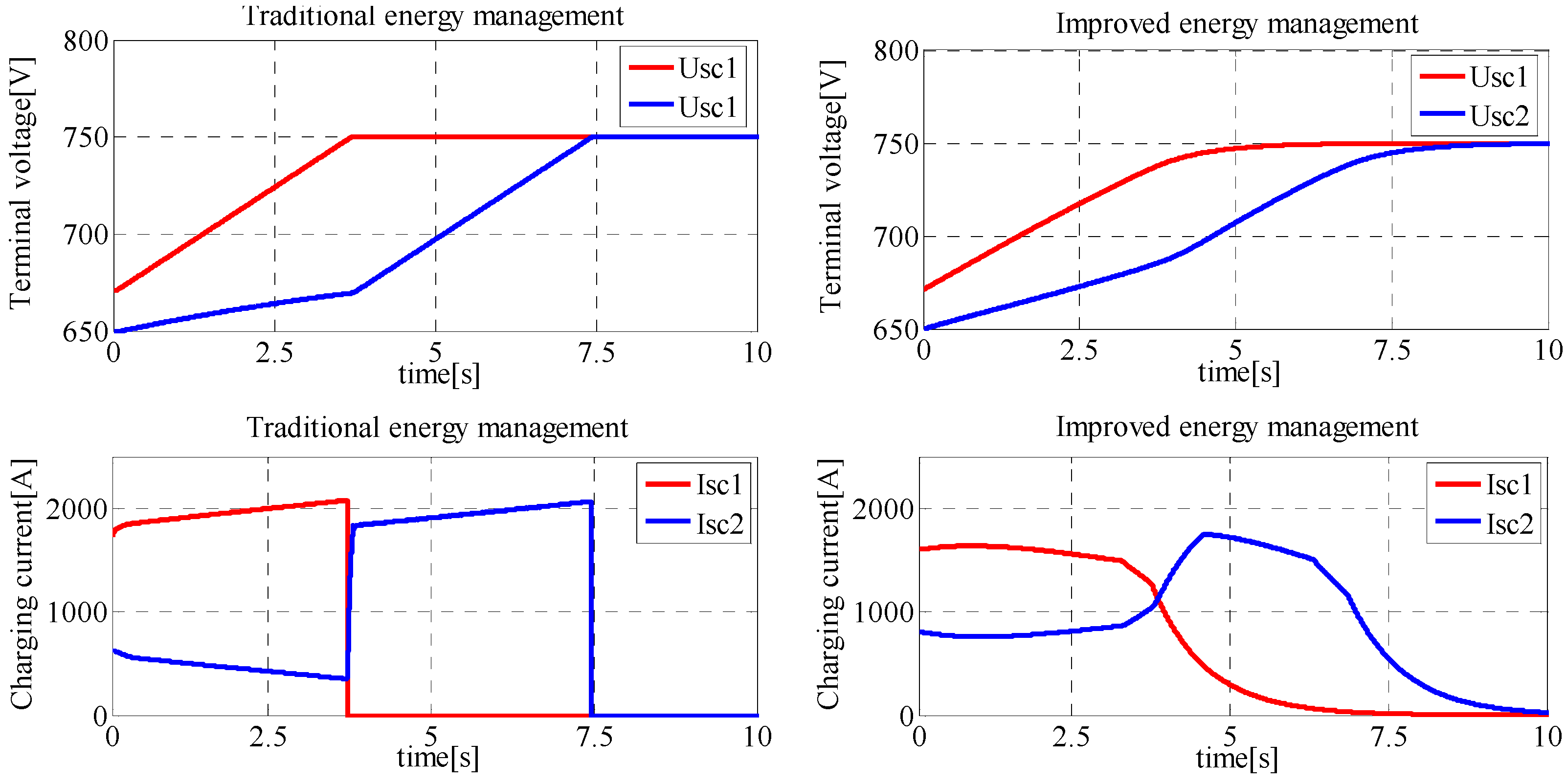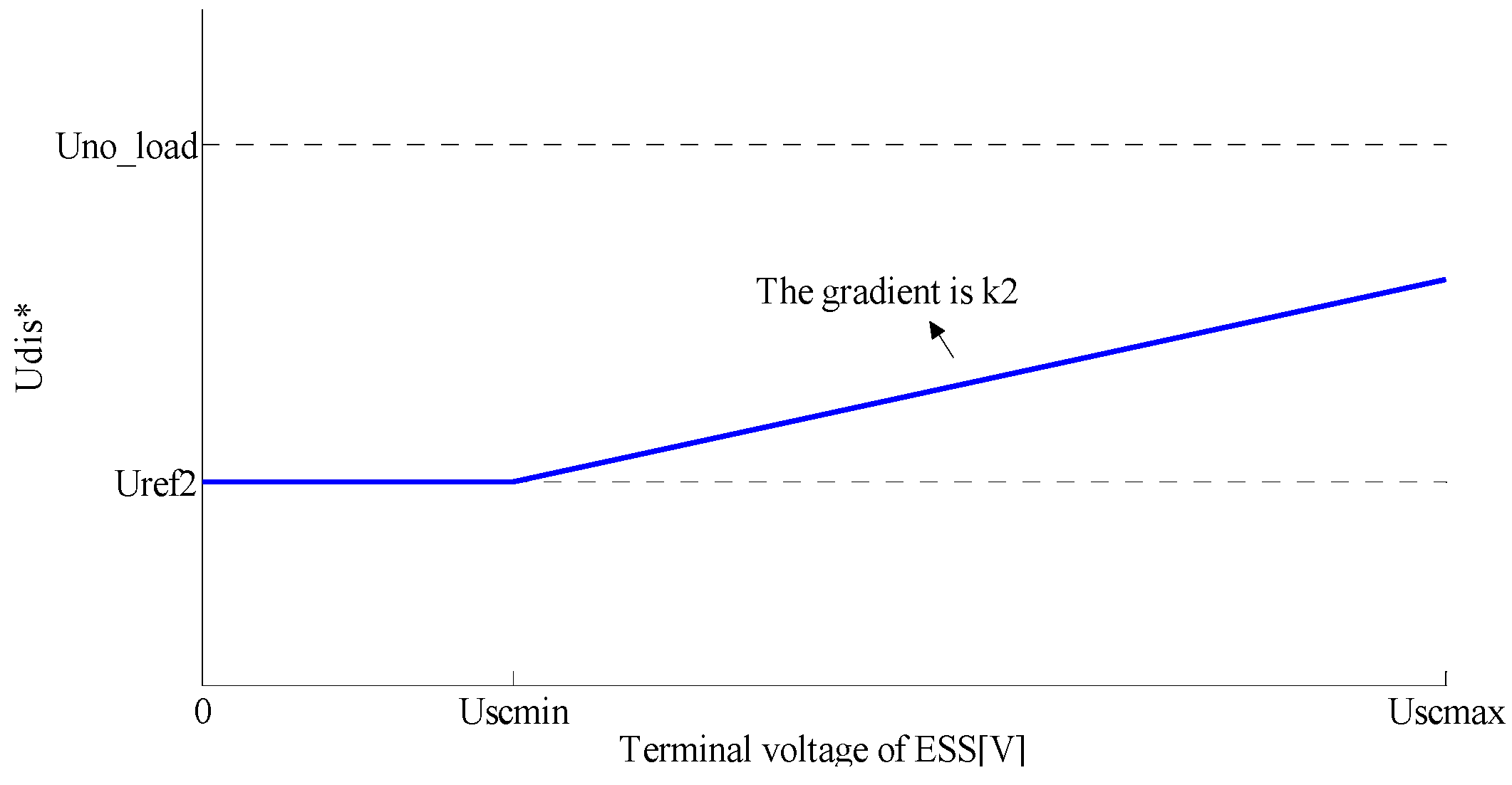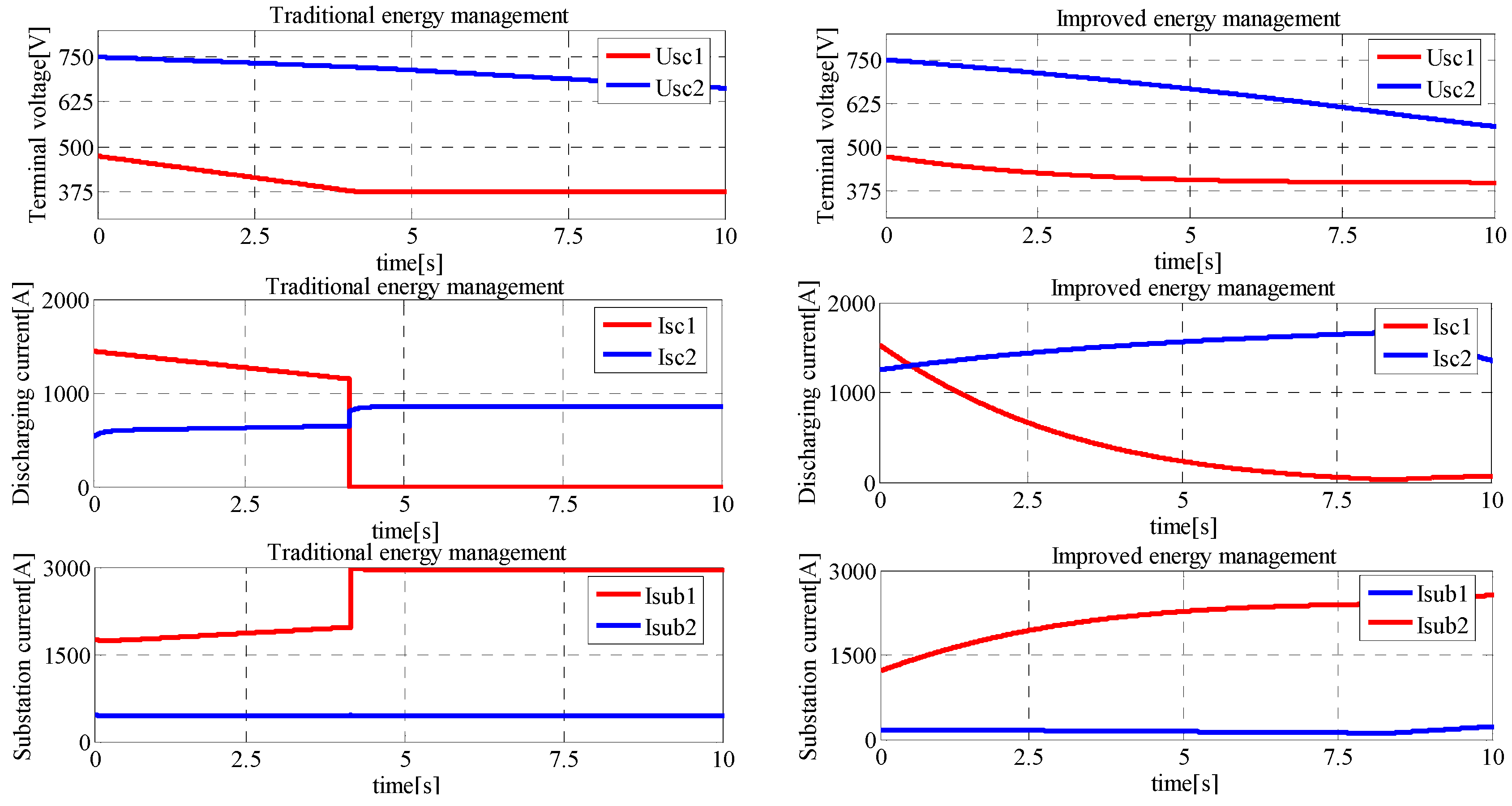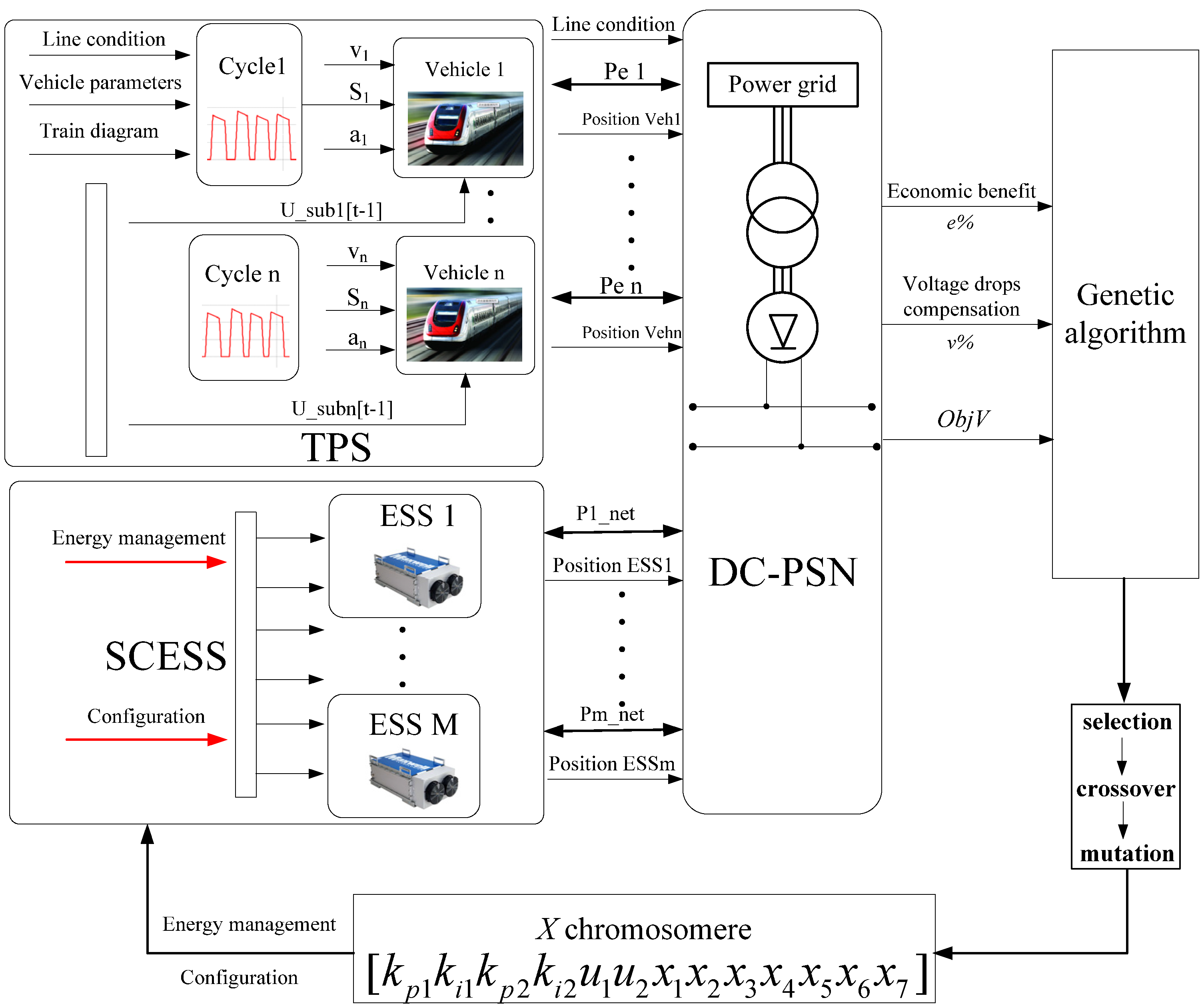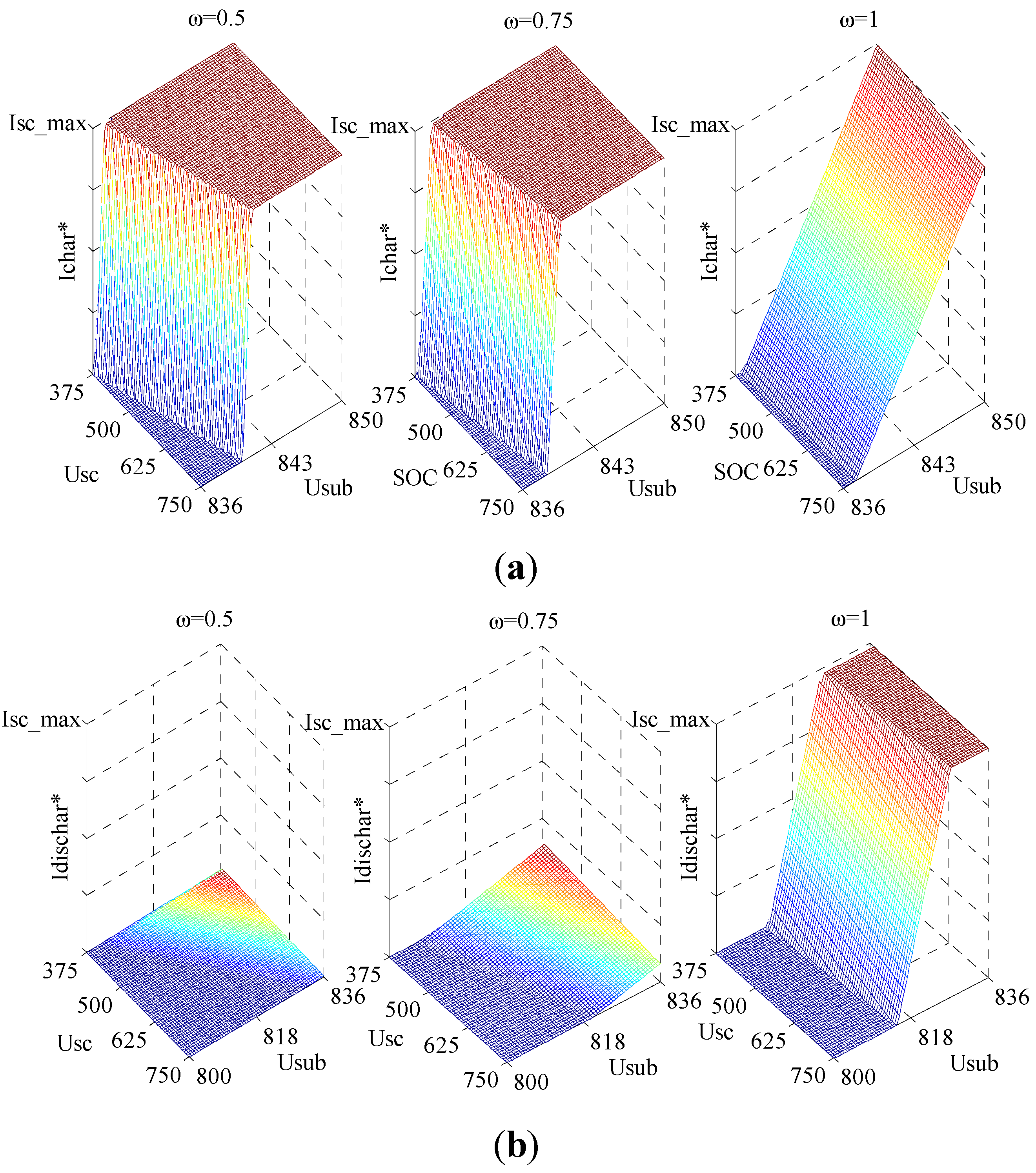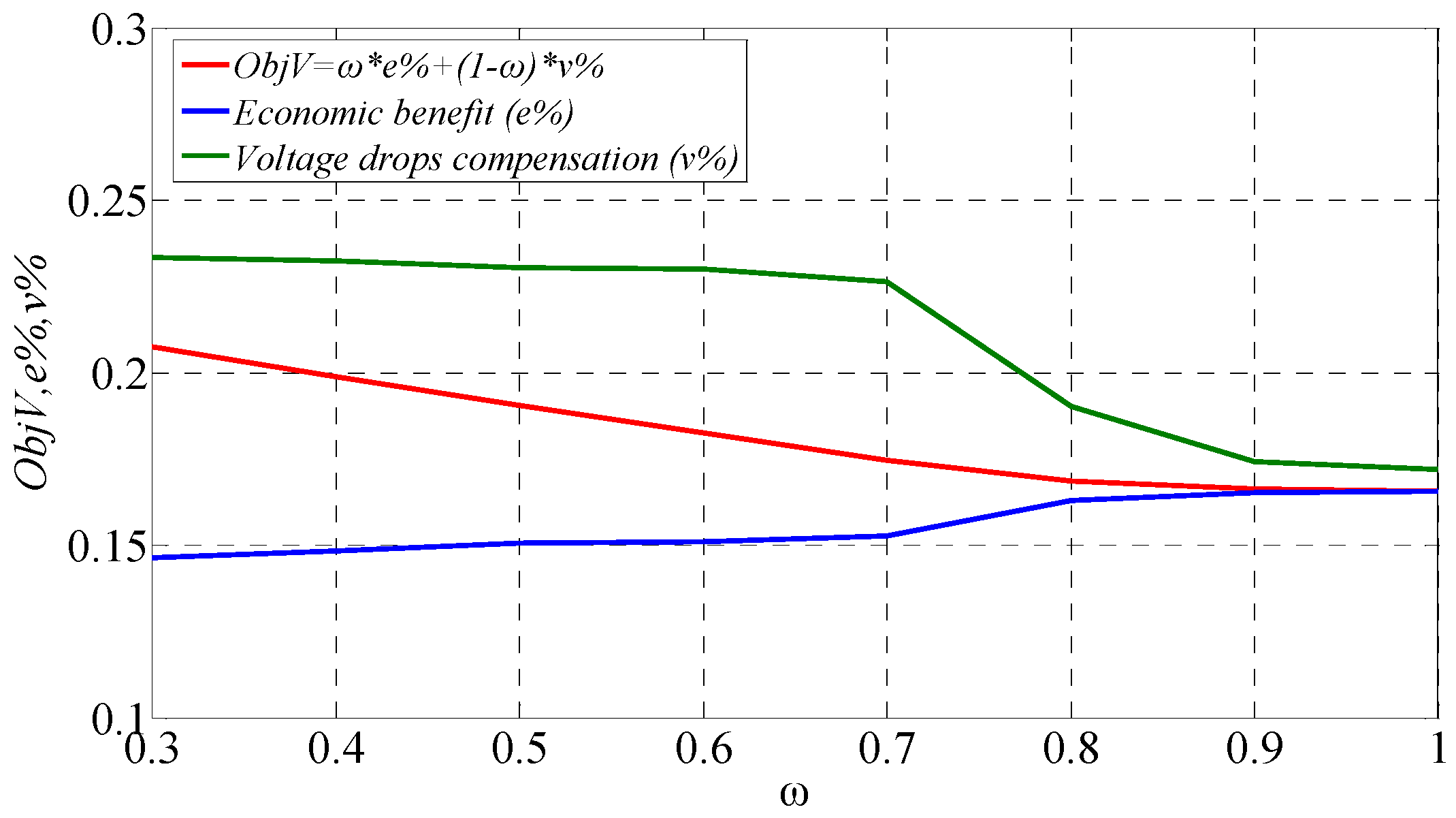4.1. Improved Energy Management Strategy
In order to improve economic efficiency
and voltage drop compensation
of ESSes, an improved energy management strategy is put forward, which decides the charging and discharging current of the ESS by detecting the voltage of substation, ESS and train pantographs, as shown in
Figure 9.
The improved energy management strategy can be divided into three parts: SOC constraint, current loop, and energy management. Due to the function of the SOC constraint, the working range of the SOC is 0.25–1, and the terminal voltage of ESSes is limited between 375 V and 750 V. Energy management can switch four work states to produce appropriate reference Psc* for the ESS according to the substation voltage and pantograph voltage of the trains. The current loop can control the charging and discharging current of the super-capacitor ESS according to the reference Isc*.
Figure 9.
The improved energy management strategy of stationary ESSes.
Figure 9.
The improved energy management strategy of stationary ESSes.
The charging and discharging current reference
Isc* of the super-capacitor ESS can be calculated by Equation (15). And work states of super-capacitor ESS are shown in
Figure 10.
Figure 10.
Work states of super-capacitor ESS.
Figure 10.
Work states of super-capacitor ESS.
State 1: When the voltage of substation is higher than charging threshold value
Uchar*, the magnitude of the charging current reference
Psc* is determined by the PI controller according to the difference value between the present substation voltage and the threshold value
Uchar*. From Equation (16), if the electric braking power of train is small, the super-capacitor ESS will absorb all the regenerative braking energy and maintain the substation voltage at
Uchar*. Then, if the electric braking power of train is excessive, the super-capacitor ESS will absorb the braking energy with maximum charging current. The value of
Uchar* will increase with the increase of ESSes’ terminal voltage, which enlarges the charging current of ESSes with smaller terminal voltage of ESSes significantly, as shown in
Figure 11. The value of
Uscmin is set to 375 V in this paper.
Figure 11.
The values of Uchar*.
Figure 11.
The values of Uchar*.
When the train is braking in one substation, by traditional energy management, the ESS installed in the substation will draw high power of regenerative energy and take no account of its terminal voltage and stored energy [
16]. When the ESS is charged up to 100% with the regenerative energy, its terminal voltage would be 750 V and its charging current will be interrupted instantaneously, which leads to the drastic changes of substation current and line current, then all the regenerative energy of trains flows to the ESSes in the near substations as shown in
Figure 12. ESSes are charged in turn and both with large current. On the contrary, by the improved energy management strategy, the ESS can adjust the threshold value
Uchar* according to its terminal voltage and achieve smoother changes of terminal voltage and charging current. Consequently, the regenerative energy is distributed to ESSes more evenly. It is worth mentioning that the improved energy management strategy reduces the line loss greatly and it also contributes to balance the terminal voltage for all different strings of ESS on a substation.
Figure 12.
Terminal voltage and charging current of ESSes.
Figure 12.
Terminal voltage and charging current of ESSes.
State 2: When the voltage of substation fluctuates between the charging threshold value
Uchar* and the discharging threshold value
Udis*, super-capacitor ESS maintain the standby state.
State 3: When the voltage of substation is less than the discharging threshold value
Udis* and pantograph voltage of trains within one substation spacing range of ESS is higher than the low voltage threshold
Ulow, discharging power reference
Psc* of ESS is determined by the substation voltage
Usub and ESS terminal voltage
Usc simultaneously as follow:
The value of
Udis* will increase with the increase of ESSes’ terminal voltage as shown in
Figure 13, which enlarges the discharging current of ESSes with larger terminal voltage and balances SOC of ESSes significantly. When the accelerated train draws the energy in one substation, all ESSes nearby can deliver energy to shave the power of substations and compensate the voltage drops of the pantograph. As shown in
Figure 14, by traditional energy management, the ESS installed in the substation will deliver highest power of energy and take no account of its terminal voltage and stored energy. When terminal voltage of one ESS decreases to
Uscmin, its discharging current will be interrupted instantaneously, which also leads to drastic changes of substation current and line current. On the contrary, the improved energy management strategy can achieve smoother changes of voltages and currents in the system, and ESSes with higher SOC tend to deliver more energy to the supply network. Thus, by the improved energy management strategy, the flow of energy can be managed more steadily and effectively, and the line loss can be reduced greatly.
State 4: When the voltage of substation is less than discharging threshold value Udis* and the pantograph voltages of trains within one substation spacing range of ESS are less than the low voltage threshold Ulow, super-capacitor ESS will deliver the energy with maximum discharging power. According to appropriate setting of Kp2, Ki2, k2, Uref2, Ulow, ESS will retain proper energy when the pantograph voltage of a nearby train is acceptable, and when the pantograph voltage of a nearby train is very low, ESS delivers maximum discharging power to shave the peak power of the substation and compensate the pantograph voltage drop.
Figure 13.
The values of Udis*.
Figure 13.
The values of Udis*.
Figure 14.
Terminal voltage and discharging current of ESSes.
Figure 14.
Terminal voltage and discharging current of ESSes.
In improved energy management strategy, Kp1, Ki1, k1, Kp2, Ki2, k2, Ulow, Uref1, Uref2 are nine undetermined parameters. In order to obtain best performance of system based on economic efficiency and voltage drop compensation , the most appropriate parameters of improved energy management strategy and ESS configuration on each substation will be obtained simultaneously by the optimization method based on a genetic algorithm.
4.3. Optimization Result Analysis
As shown in
Figure 17, the simulation comparison result between two different optimization methods with corresponding optimum
ObjV are obtained separately under different values of weight coefficient
. Based on a genetic algorithm, both optimization methods can obtain optimal
ObjV with an increase of evolution generation, but the novel optimization method can obtain much higher
ObjV. The values of maximum
ObjV as well as corresponding economic efficiency
and voltage drop compensation,
based on two optimization methods and different values of weight coefficient
are shown in
Table 7. The values of parameters to determine energy management strategy and configuration of ESSes on every substation can be obtained separately based on two optimization methods and different values of weight coefficient
, as shown in
Table 8 and
Table 9.
Figure 17.
Simulation comparisons of two optimization methods.
Figure 17.
Simulation comparisons of two optimization methods.
Table 7.
Maximum ObjV obtained by different optimization method.
Table 7.
Maximum ObjV obtained by different optimization method.
| Optimization Method | ω | Maximum ObjV | Economic Efficiency e% | Voltage Compensation Rate v% |
|---|
| Traditional optimization | 0.5 | 14.29% | 14.65% | 13.93% |
| Traditional optimization | 0.75 | 14.50% | 14.72% | 13.84% |
| Traditional optimization | 1 | 14.76% | 14.76% | 13.70% |
| Novel optimization | 0.5 | 19.06% | 15.06% | 23.05% |
| Novel optimization | 0.75 | 17.11% | 15.79% | 21.06% |
| Novel optimization | 1 | 16.56% | 16.56% | 17.20% |
Table 8.
The parameters of optimal energy management strategies.
Table 8.
The parameters of optimal energy management strategies.
| Optimization Method | ω | Energy Management Strategy of ESSes |
|---|
| kp1 | ki1 | k1 | kp2 | ki2 | k2 | Ulow | Uref1 | Uref2 |
|---|
| Traditional optimization | - | 50 | 50 | - | 50 | 50 | - | - | 850.0 | 800.0 |
| Novel optimization | 0.5 | 298 | 90 | 0.011 | 0.158 | 44.39 | 0.075 | 771.0 | 836.1 | 802.0 |
| Novel optimization | 0.75 | 193 | 83 | 0.006 | 1.20 | 40.34 | 0.037 | 772.0 | 836.2 | 806.4 |
| Novel optimization | 1 | 18 | 76 | 0.002 | 19.33 | 39.85 | 0.008 | 779.1 | 836.5 | 811.8 |
Table 9.
Optimized location and size of ESSes.
Table 9.
Optimized location and size of ESSes.
| Optimization Method | ω | TSS No. and Set Numbers of ESSes |
|---|
| 1 | 2 | 3 | 4 | 5 | 6 | 7 |
|---|
| Traditional optimization | 0.5 | 0 | 16 | 15 | 0 | 10 | 0 | 13 |
| Traditional optimization | 0.75 | 0 | 14 | 15 | 0 | 10 | 0 | 14 |
| Traditional optimization | 1 | 0 | 14 | 15 | 0 | 10 | 0 | 13 |
| Novel optimization | 0.5 | 0 | 18 | 11 | 0 | 17 | 0 | 17 |
| Novel optimization | 0.75 | 0 | 18 | 10 | 0 | 10 | 0 | 17 |
| Novel optimization | 1 | 0 | 14 | 16 | 0 | 8 | 0 | 7 |
From
Figure 17 and
Table 7, whatever the value of
, novel optimization method can obtain much higher
ObjV,
e% and
v% compared to traditional optimization method. With the increase of
from 0.5 to 0.75 to 1, the maximum
ObjV of ESSes obtained by traditional optimization is 14.29%, 14.50%, and 14.76%, which can be increased to 19.06%, 17.11%, and 16.56%, respectively, by the novel optimization method. And both economic efficiency
e% and voltage drop compensation
v% can be improved effectively by the novel optimization compared to traditional optimization. By the novel optimization method, economic efficiency
can be improved because of more appropriate energy management, less line loss, and voltage drop compensation
can be improved effectively because of the function of
Ulow.
From
Table 8, the adopted energy management strategy of the traditional optimization method is constant, and it is only determined by six parameters. By contrast, the energy management strategy obtained by the novel optimization method is determined by nine parameters. The novel optimization method can optimize the energy management, location, and size of ESSes simultaneously. Under different values of weight coefficient
, the best energy management strategy is different and among the nine relevant parameters appear some regularities.
kp1,
k1,
kp2,
k2 are more important factors that affect the performance of the metro system, and
ki1,
ki2,
Ulow,
Uref1,
Uref2 have smaller changes. Without regard to the integral term, the best energy management strategy of ESSes for different value of weight coefficient
is shown in
Figure 18. For charging energy management strategy, the value of
kp1 (the slope of charging current
vs. Usub) and
k1 (the slope of charging current
vs. Usc) decrease with the increase of weight coefficient
. For discharging energy management strategy, the value of
kp2 (the slope of discharging current
vs. Usub) increases and
k2 (the slope of discharging current
vs. Usc) decrease with the increase of weight coefficient
.
Table 9 shows the optimal location and size of ESSes obtained by two different optimization methods. By contrast, two optimization methods ultimately configure super-capacitor ESSes in same location of substations, and the size of ESSes tend to be smaller with the increase of weight coefficient
. Configuring ESSes in fewer substations with one or two substation spacing and decreasing the size of ESS installed in one substation can reduce the installation cost, but the distance between the train and ESS will also increase, which causes higher line loss and less energy recovered and voltage drop compensation
will also decrease. The best compromise between economic efficiency
and voltage drop compensation
under different value of weight coefficient
can be obtained by two optimization methods. Compared to the traditional optimization method, the best configuration of ESSes obtained by the novel optimization method changes are more intense and it can achieve much higher
ObjV under different values of weight coefficient
.
The maximum
ObjV with corresponding economic efficiency
and voltage drop compensation
for different value of weight coefficient
can be obtained by novel optimization method as shown in
Table 10 and
Figure 19. From
Figure 19, when
increases from 0.3 to 1, Economic efficiency
increases from 0.1465 to 0.1656, and voltage drop compensation
decreases from 0.2335 to 0.1720. According to its own optimization requirement and the concrete result obtained by the novel optimization method in
Figure 19, Subway Company could choose the best value of weight coefficient
for itself.
Figure 18.
Best energy management strategy of ESSes. (a) Charging energy management strategy; and (b) discharging energy management strategy.
Figure 18.
Best energy management strategy of ESSes. (a) Charging energy management strategy; and (b) discharging energy management strategy.
Table 10.
Optimal ObjV, e% and v% obtained by novel optimization method.
Table 10.
Optimal ObjV, e% and v% obtained by novel optimization method.
| 0.3 | 0.4 | 0.5 | 0.6 | 0.7 | 0.8 | 0.9 | 1 |
| ObjV | 0.2074 | 0.1989 | 0.1906 | 0.1826 | 0.1747 | 0.1685 | 0.1663 | 0.1656 |
| e% | 0.1465 | 0.1485 | 0.1506 | 0.1509 | 0.1525 | 0.1631 | 0.1654 | 0.1656 |
| v% | 0.2335 | 0.2325 | 0.2305 | 0.2301 | 0.2265 | 0.1902 | 0.1744 | 0.1720 |
Figure 19.
Optimal ObjV, e% and v% obtained by the novel optimization method.
Figure 19.
Optimal ObjV, e% and v% obtained by the novel optimization method.

